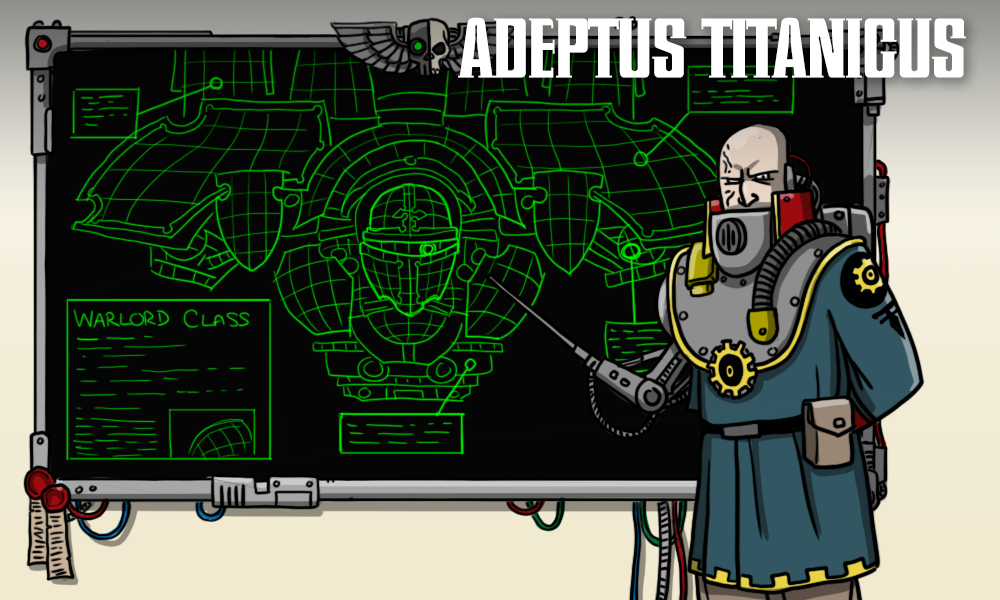Welcome back to Goonhammer’s series for aspiring Titan Principes. We here at Goonhammer’s own Collegia Titanica know that Adeptus Titanicus can seem intimidating to players unfamiliar with its particular quirks, but this series aims to equip you with everything you’ll need to play out epic clashes on the battlefields of the far future with your very own Titan Battlegroup. In this series, we’ll be taking a more in-depth look at the various Legios of the Collegia Titanica – exploring their origins and how to use them on the tabletop, from maniple selection and their loadouts, through to how to command them on the field of battle to secure ultimate victory.
This week, we’re looking at the other Titan Legion released in the Core Rulebook: Legio Tempestus. The Stormlords offer legion traits that lend themselves to a fast-moving offensive playstyle no matter what Titans you want to bring to bear. Read on as we walk you through what this famously aggressive legion brings to the table.
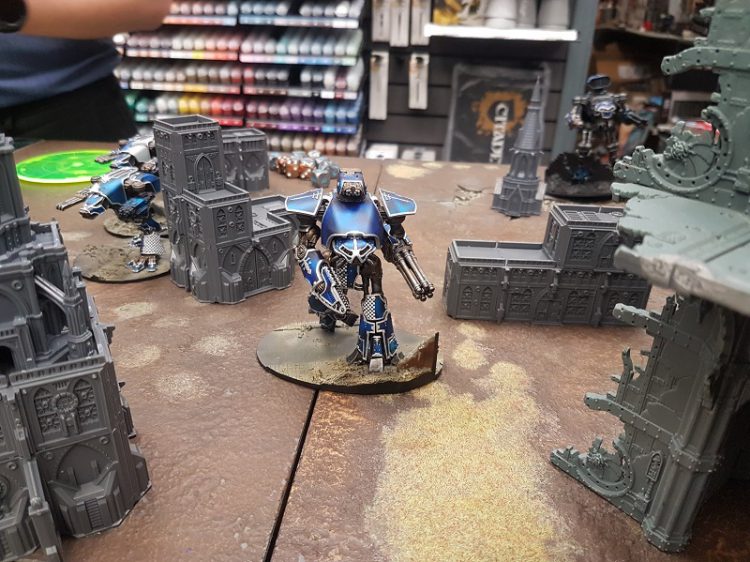
Who are the Legio Tempestus?
Hailing from Mars and founded during the Age of Strife, Legio Tempestus was one of the first three Legions of the Collegia Titanica, the Triad Ferrum Morgulus. As a result, they have an illustrious honour roll for their efforts during countless compliance actions during the Great Crusade.
Tempestus were legendary for their ability to strike like lightning, using orbital drops to get their God-Engines right into the front line of compliance actions, and weathering the worst circumstances that would make others falter, earning them the Low Gothic name of the “Stormlords”.
The outbreak of the Horus Heresy saw the Legio schism, with the majority of elements of the Legio, who were with Horus’ Expeditionary Fleets, side with the Warmaster. They would later be known as Legio Tempestor.
The forces on Holy Mars, however, remained true. Their fate is one of the main threads in the novel Mechanicum by Graham McNeil, which you should check out. They fought gloriously against overwhelming odds in a last stand against Legio Mortis, making them pay a heavy price to take Magma City.
Some of the loyalists survived the Horus Heresy and have moved to defend a new Forge World, Orestes. They’ve since been involved in various wars, including the Sabbat Worlds Crusade in M.41.
Painting Legio Tempestus

We asked our friend Neil (@artisans_of_vaul) for his method for painting up his gorgeous Stormlords battlegroup.
In the background they are described as having a “cobalt blue” armour, which to me meant something slightly metallic/ shiny in appearance. I went for a blended, mottled look which looks different to the urban camouflage style in one of the HH books; this was intentional to set them apart as being Loyalist (though these colours could easily be used to make an urban camo scheme).
First things first, this does require an airbrush for the armour plates, especially for the final layers. If you don’t have an airbrush I can’t emphasise enough how worth your time and money it is to get one. It turns the “tedious” parts of painting into a quick and painless process allowing you to get onto the more fun bits!
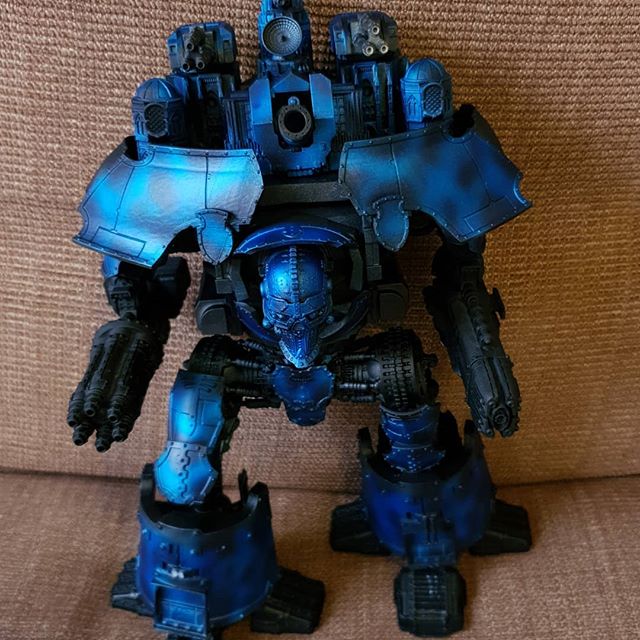
- Basecoat in black.
- Airbrush most of the armour using Gungrey Air from Vallejo (71.072) but leave some patches black. I normally do this in a combination of painting quick wiggly “lines” over the armour plates that cross over one another at random.
- At this point you need to start being more selective with the airbrushing to bring out the interesting patterns in the lines you have just created. Add thinner lines over the middle of some of the Gungrey, I normally focus on where the lines cross as well using spots/mottles of the lighter shades. First Shining Silver from Army Painter and then even thinner lines of Speed Metal from Scale Colour.
- Pick out the panel lines and around the trim using Dark Tone from Army Painter.
- Finally to add the blue colour mix Talassar Blue contrast paint (GW) mixed with Vallejo Satin Varnish (3:1) and airbrush in thin layers over the armour so that the contrast paint doesn’t pool. I normally do this over two or three layers.
Tempestus in Adeptus Titanicus
Games Workshop seem to have (mostly) put the Stormlords on the Warmaster’s side – they appear in the core rules along with the loyalist Legio Gryphonicus, and the Traitor Titans of Legend pack includes Mantellum Fulmen, a Legio Tempestus Warhound. However, you could just as easily build your force as a loyalist battlegroup, since about half of the legio stuck with the Emperor after Horus rebelled. Whatever you choose, Tempestus bring a solid set of options that can be useful no matter how you want to build your list.
Tactical Overview
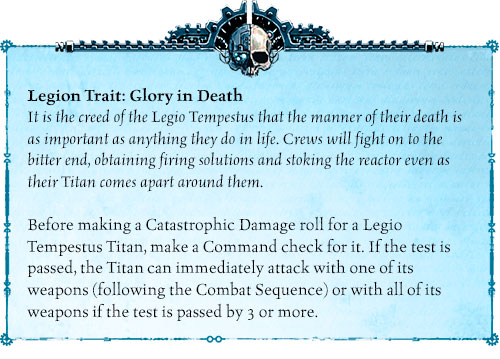
Just like Gryphonicus, Legio Tempestus has two maniple traits to play with. Echoing their last stand on Mars, Glory in Death gives each of your Titans a chance to fire one of its weapons just before it makes a Catastrophic Damage roll, assuming it passes a Command check. If it passes by 3 or more, it gets to fire with all of its weapons instead. This trait makes it harder to deny a Legio Tempestus Titan any shooting by killing it, instead merely mitigating the likely damage it’ll deal in that battle round. Keep in mind that its effect is more powerful the better your Command check, but you’ll get more chances to use it with more models on the board. This creates a sort of tension – do you want to take larger, more expensive Titans with better Command values so you’re more likely to get free shots when they die, or go wide with more Titans to have as many chances to roll for it as possible? On balance, we recommend taking more Titans over going all in on some more expensive ones, since building around a trait that requires you to lose your pieces is incredibly risky. However, this trait that will work with any list, so feel free to experiment to find what works for you.
Fury of the Machine saw a total rewrite in the Traitor Legios book. Now, once per round when a Tempestus Titan that has one or more critical damage can add 1 to the Strength of a weapon before it fires. The weapon has to start at least S4 and this rule cannot increase it past S10 so is a little limited in use but being able to crank a laser blaster up to S9 or a macro gatling up to S8 can be huge in the mid to late game when you can expect for this to come up.
Fortunately, Combat Drop, also saw an overhaul and is now actually useable. At a cost of 3 stratagem points its still expensive but allows you to place a Titan of scale 7 or lower into reserve and drop it in mid-game. At the start of any strategy phase from turn 2 onwards you get to place the titan more than 3″ away from any enemy and then scatter it D6″. If it hits any terrain when scattering it takes D3+2 S9 hits with void shields allowed. If instead it scatters into a model of a scale lower than the titan’s then just move it the shortest distance so its not overlapping BUT if it scatters into something of equal or greater scale then your titan is automatically destroyed without rolling Catastrophic damage and the titan it hits suffers a normal collision. So long as it has survived the fall it doesn’t get to move but can shoot. Being able to drop a Warhound in behind enemy lines, especially behind or next to a heavy maniple like the Extergimus can be massive, allowing more flexibility for you and keeping the enemy titans on their toes.
Their legion-specific wargear, Chasmata Pattern Laser Destructors, is neat, if somewhat expensive. It gives you 3” of extra long range on turbo-laser destructors and laser blasters, letting you hit from further away than your opponents. It also extends the short range by 6”, which lets you pick up some hits without the penalty you might otherwise miss out on. Finally, a few extra inches could be the difference between having a shot with Glory in Death or not, making it harder for your enemies to take your Titans out without facing potential reprisal. If you have the points in your list, it’s useful, but probably isn’t worth building your battlegroup around.
Of their personal traits, Storm-born is the standout. Boosting speed without pushing the reactor is always nice, and the restriction to Titans with the Charge order isn’t as bad as you’d think – a charging Titan doesn’t have to end its move next to an enemy, it just gives up the ability to turn once it starts moving. As long as you plan your turns well so you don’t need fine manoeuvring to get where you’re going, this Trait can help you manage your reactor while covering the board quickly. And if you do manage to set this up to get a long charge into an enemy Titan, picking up a few extra dice without having to push your reactor is always nice.
Defiant Warrior is interesting, but probably doesn’t compete with Storm-born or the good choices from the generic list. However, re-rolls are always nice, and it will almost certainly mean that your Princeps gets to re-roll 1s on its Glory in Death attacks. Adamantium Resolve isn’t a good choice. Skip it.
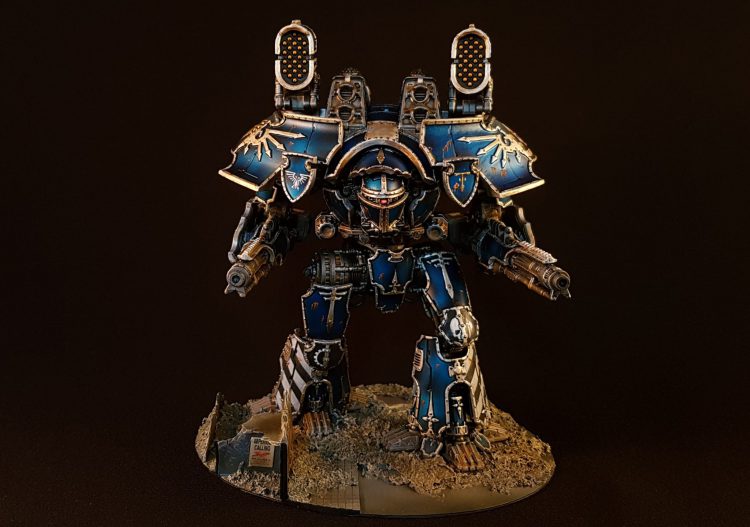
Maniple Choice
The Stormlords are pretty flexible and don’t force you down one particular avenue of titan chassis or maniple selection. Glory in Death has a chance to trigger each time one of your Titans dies, and Fury of the Machine is more likely to trigger the lower your Command check. These rules favour aggressive play, making pushing your reactor less risky and giving you a chance to shoot when you die, so you’ll want to build your list to take the initiative and close with your opponent’s forces, daring them to strike back. You’ll probably want to focus your build on Reavers and fill out with Warhounds: Reavers bring good weapons without breaking your points budget, and Warhounds are cheap and can bring plasma blastguns, which are great options for your free shot when it dies. They also both have the potential to close quickly with your opponent and threaten them from up close, letting you get the most out of your legion traits.
As a result, we would suggest leaning towards lighter maniples focused around Reavers and Warhounds. Their relatively low point cost means that you can fit two of them in a battlegroup to give you multiple Personal Traits in larger games, as well as allowing you to customize your strategy by taking advantage of multiple maniple traits.
- Lupercal is a strong complement to any list, allowing you to play for activation advantage in the first turn and then go for the turn 2/3 alpha strike once you are in position. Bringing multiple Warhounds will give you ample chances to roll for Glory in Death even if those roles are a bit tougher to get.
- The Ferrox maniple is one of our favourites, favouring aggressive play for getting in close with a mix of Reavers and Warhounds. Running a Ferrox will give you plenty of activations and a straightforward yet powerful maniple trait.
- A Corsair maniple is a strong complement to Storm-born: extra manoeuvrable Reavers with free boosted charges is nothing to sneer at.
- The Venator maniple also has a good mix of Titans, however a clever opponent will attempt to deny your free shots by being out of arc of your Reaver. The Ferrox is easier to use, but this can be a powerful option.
If you want to bring a larger Titan, the new options in Shadow and Iron have some great ways to do that without sacrificing too much in terms of number of Titans on the field.
- The Mandatum maniple is an interesting way to sneak a Warlord in. Just keep in mind that the bonus to Command checks for the Warhounds only applies to checks made to issue orders – it will not make you more likely to trigger Glory in Death. Take a “brawler” Warlord and push its reactor aggressively to take advantage of your maniple and legion traits.
- If you want to try out a Warbringer-Nemesis, consider the Arcus maniple. A Warbringer equipped with laser blasters and Chasmata-Pattern Laser Destructors will be able to fire at targets through buildings from relative safety, while the pack of Warhounds you’ll bring with it run circles around their foes.
In terms of Knight Household support, they can provide a useful role in terms of urgent threat or ranged shield breakers, but they won’t synergize with your trait like they do for Gryphonicus. If you want to take Knights, you should feel free to bring a banner or two, but they’re not an auto-include in the same way as they are for some other legions.
With all that in mind, let’s take a look at a 1750 point list which takes advantage of the unique rules Legio Tempestus offers. This list is a solid starting point for a beginning player, but also has plenty of options for a veteran to play around with:
Legio Tempestus Battlegroup – 1745 pts
Ferrox Light Maniple – 770 pts
Reaver Titan – 330 pts
- Princeps Seniores – Stormborn
- Vulcan Megabolter
- Chainfist
- Chasmata Laser Blaster
- Upgrade: Bastion Shielding
Warhound Titan – 220 pts
- Plasma Blastgun
- Vulcan Megabolter
Warhound Titan – 220 pts
- Plasma Blastgun
- Vulcan Megabolter
Mandatum Maniple – 975 pts
Warlord Titan – 525 pts
- Princeps Seniores – Devoted Servant of the Machine Spirit
- Paired Gatling Blasters
- Sunfury Plasma Annihilator
- Volkite Destructor
- Upgrades: Tracking Gyroscopes, Focused Capacitors
Warhound Titan – 210 pts
- Turbo Laser Destructor
- Vulcan Megabolter
Warhound Titan – 210 pts
- Turbo Laser Destructor
- Vulcan Megabolter
We weren’t kidding when we said the Ferrox is one of our favourite maniples. This incredibly aggressive list comes in at 1495 points, and with 4-6 activations provides plenty of opportunities to trigger Glory in Death.
By opting for two maniples, we have two Princeps Seniores on the field, and each one gets a personal trait. The chainfist-equipped Reaver runs Storm-born, giving them and the other Titans in their maniple the ability to boost their speed without pushing so long as they successfully issue the Charge order – this can free up some space on your reactor track for Voids to Full or extra manoeuvres later on.
The Mandatum is a change of pace in comparison to the Ferrox, it’s not rushing in as much and the lasers on the Warhounds have longer range than plasma blastguns so they can hang out with the Warlord longer. That said the Warlord does want to get up the board anyways and Experimental Locomotors wouldn’t go amiss either. The focused capacitors made its plasma even more deadly in short range after the Warhounds strips shields and if needed the volkite can make use of Fury of the Machine to boost its strength which can be pushed to use Beam for an automatic 3 hits to whichever location the plasma just put a hole in.
The Warhounds will do what they do best: get in close and be pests. The Ferrox Knife Fighters rule stacks nicely with running in a squadron, giving you a +2 to armour rolls when coordinating strikes at nearby targets. If you do choose to squadron up you will end up with 4 activations, which is a bit on the low side, so before deployment you could choose not to if you would rather have more. You’ll want to play this by ear depending on your opponent’s list.
There is a bit of room to make changes to this list if you want. The weaponry on the Reaver and Warlord could be tweaked to your taste. You could also shuffle the personal traits around, such as swapping one for Swift Killer in the core rules – it imposes a hit penalty, but will let you set up shots you wouldn’t otherwise be able to make, and can be used with Glory in Death if your princeps gets taken down without a viable target.
Once you’ve got a few games under your belt, this list will leave you well positioned to try out even more strategies, including what we believe is one of the strongest all-round list structures in the game: a Corsair and a Lupercal.
Playing Against Tempestus
Consider prioritizing damage to Tempestus Titans’ head structure track if possible. While the head does tend to be better armoured than other areas, the penalties to Command checks will make Glory in Death less likely to go off, potentially denying your opponent a key part of their strategy. Be very mindful of the front arcs of titans you are about to destroy, especially if it’s a Warlord – you don’t want to give them the opportunity to trade out if you can help it.
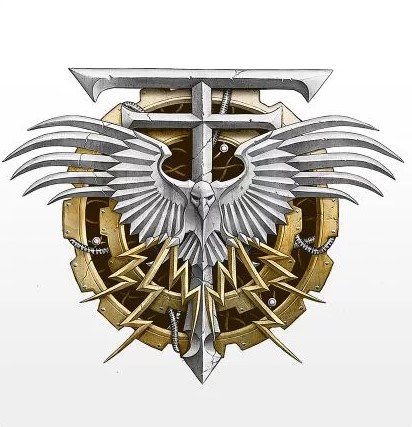
Ride the Lightning
Legio Tempestus brings some interesting traits that reward you for playing aggressively and daring your opponent to fight back. Stride forward and take the fight to the enemy, and if they take you down, go out in a blaze of glory!
